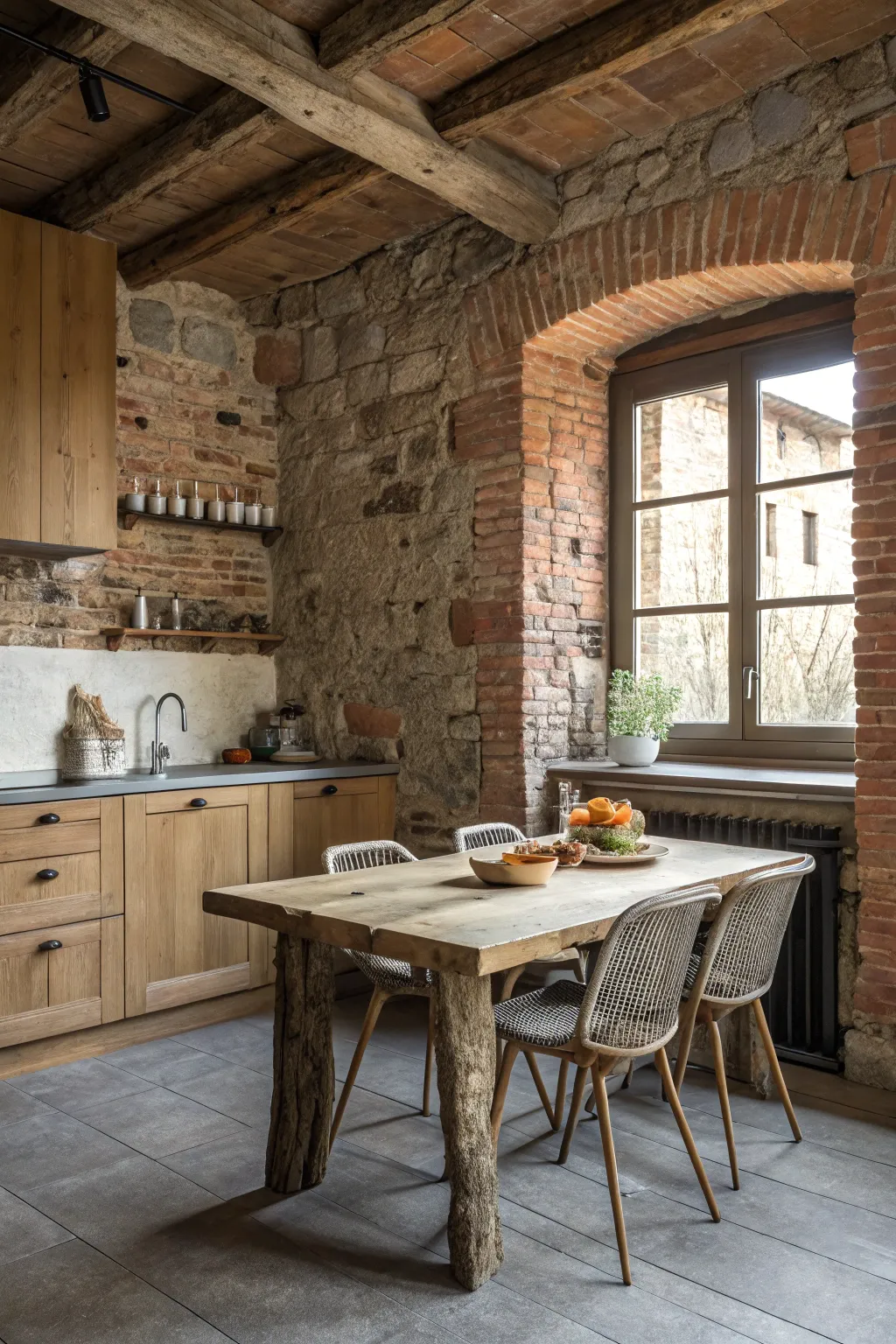A rustic kitchen is more than just a space for cooking—it’s where stories are shared, laughter echoes, and memories are made. The warmth of wood, the rugged simplicity, and the inviting textures blend together to create a feeling you can’t find just anywhere.
Ready to discover the secrets of transforming your kitchen into a cozy rustic retreat?
1. The Art of Balance: Pairing Modern Perks with Vintage Charms
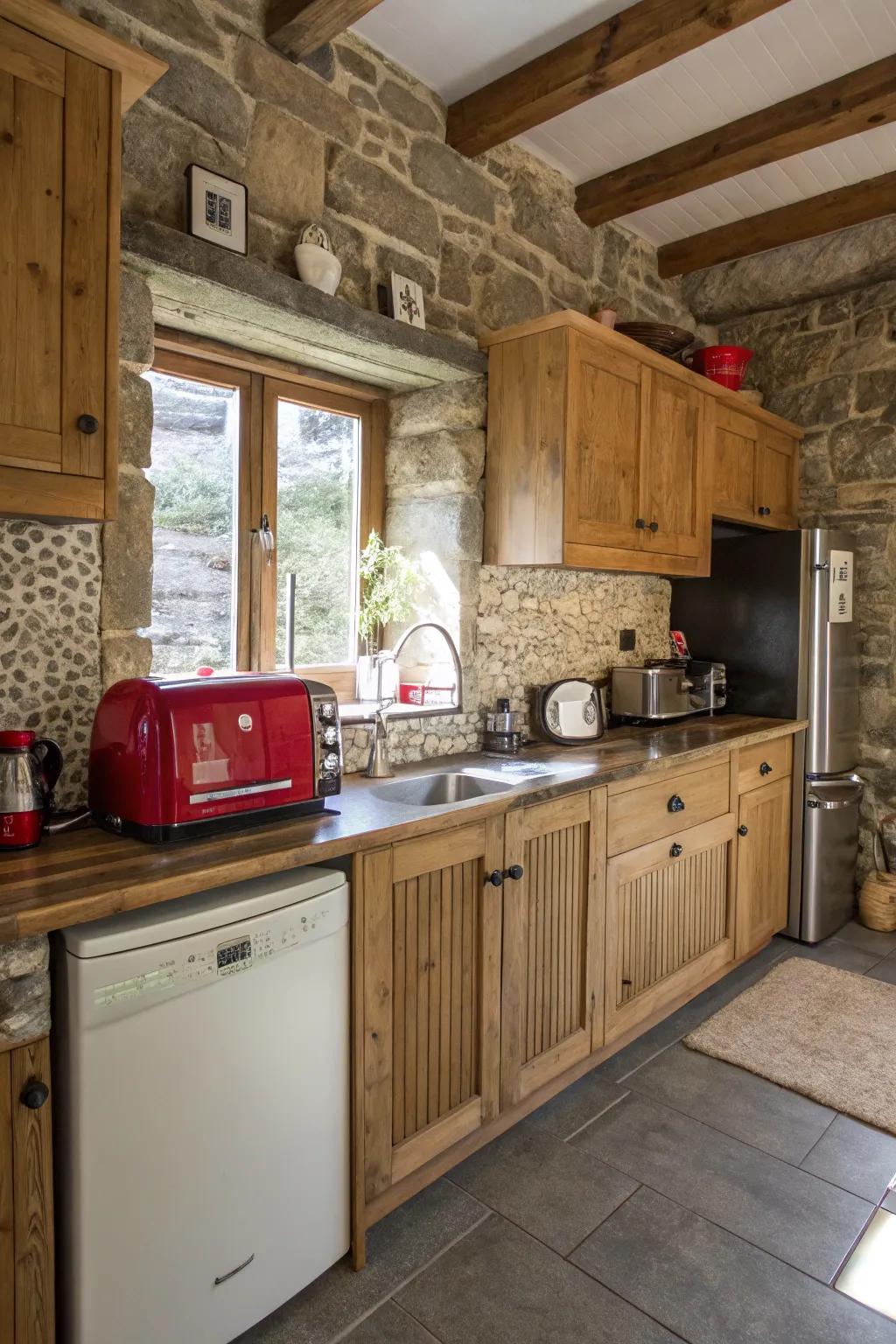
There’s something magical about a kitchen where old meets new. I’ve always been drawn to the way modern convenience and vintage style can harmonize, creating an atmosphere that’s as inviting as it is practical.
Why choose between cutting-edge performance and classic nostalgia when you can have both? I love playing matchmaker—pairing the clean lines of contemporary appliances with the soulfulness of retro designs. It’s all about curating a layered look where stainless steel and pastel enamel, smart tech and analog dials coexist in harmony.
Let me tell you about a project I worked on with the charming duo, Linda and James. They had inherited a stunning 1950s kettle from Linda’s grandmother, and James was obsessed with the latest smart refrigerator. Finding common ground, we created their ideal kitchen by weaving in these contrasting elements. Some of our favorite combinations included:
- A shiny new induction cooktop framed by antique brass pot racks.
- A cheerful, retro-style toaster perched beside a sleek espresso machine.
- Open wood shelving displaying both vintage Pyrex and modern ceramic bowls.
The result? Every morning felt like a warm embrace from the past with a wink to the future.
If you’re dreaming up your perfect rustic kitchen, don’t be afraid to let eras mingle. Mix, match, repeat.
Kitchens thrive on personality.
Some handy options:
2. Stone Accents: Transform Ordinary Kitchens Into Rustic Masterpieces
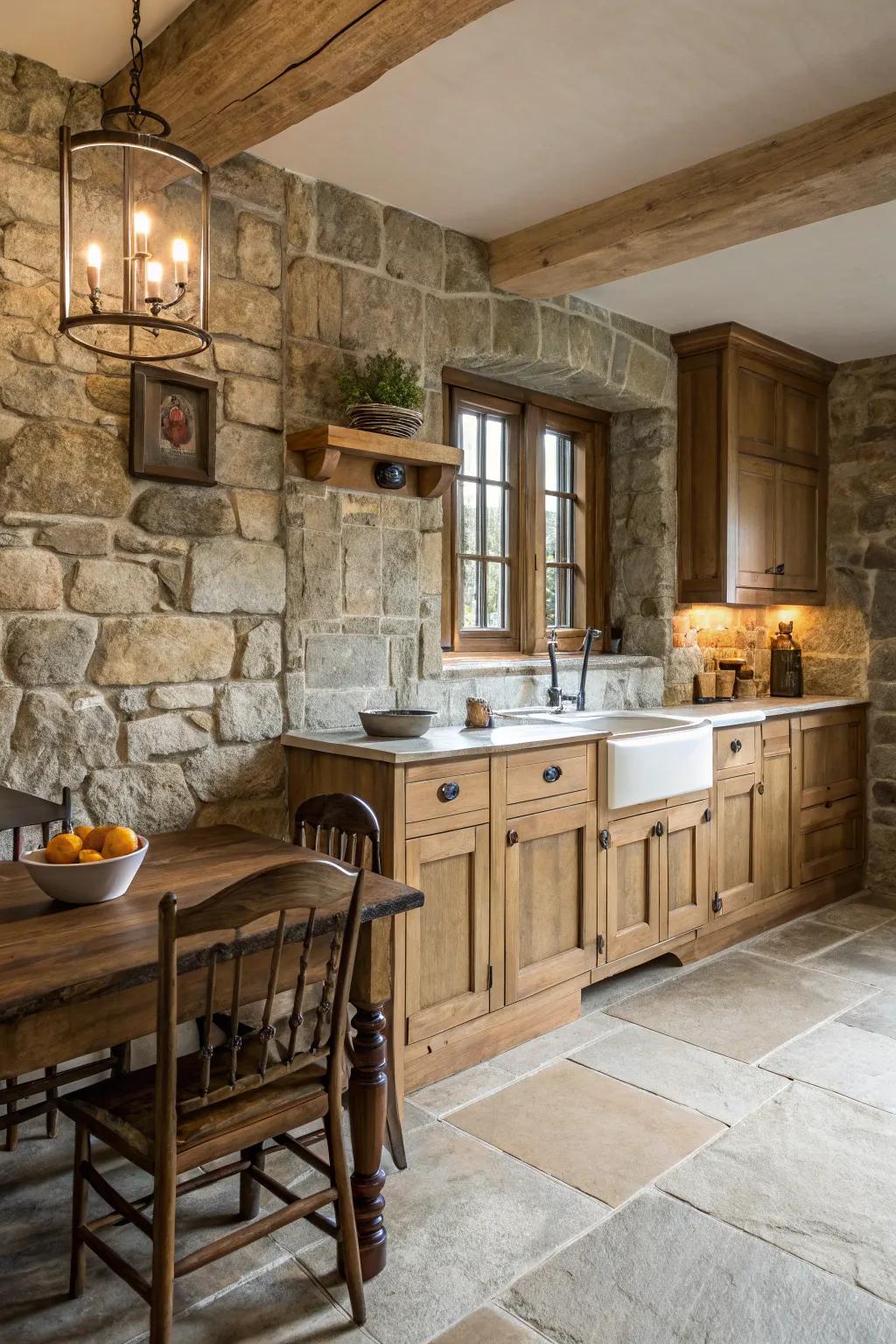
Stone is the unsung hero of the rustic kitchen world. Whether it’s a feature wall, a backsplash, or subtle accents, natural stone brings an earthy ruggedness that feels both elevated and inviting. I’ve worked with clients who were initially hesitant to introduce stone, worrying it might dominate the space—but with the right touch, stone can be softly sophisticated and surprisingly warm.
Imagine a wall clad in textured stone, softly catching the light as you brew your morning coffee. The space instantly feels grounded and timeless.
If you’re pondering how to incorporate stone into your rustic haven, consider these inspiring routes:
- Natural stone wall tiles make a bold, lasting statement and work beautifully with wood and metal.
- Opt for a stone backsplash behind your stove—it’s both practical and a showstopper.
- For renters or those on a budget, peel-and-stick stone wallpaper offers a commitment-free way to test the look.
- Don’t stop at walls! Small touches, like a stone-topped kitchen island or even rough-hewn stone trivets, can subtly reinforce your rustic theme.
Blending stone with soft textiles or warm-toned wood ensures your kitchen never feels cold. In the end, it’s about creating a place where every detail invites you to linger a little longer—and maybe pour a second cup of tea.
A few relevant products:
3. Greenery Brings Joy
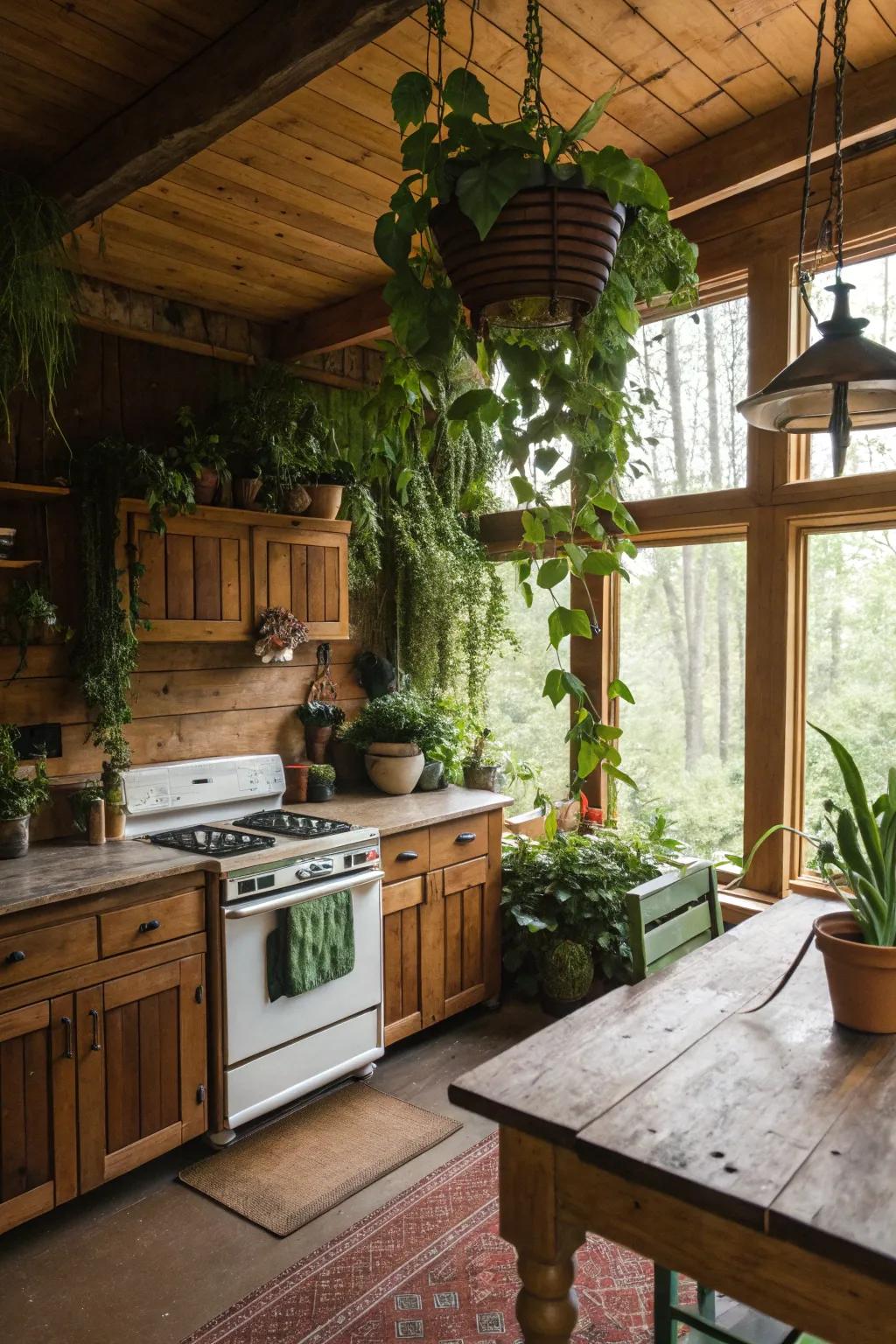
Plants have a way of instantly making a rustic kitchen feel welcoming.
A little pop of green on a windowsill or trailing from a ceiling hook can brighten any day. Why not try one of these quick ideas for a lively kitchen?
- Choose a hanging fern to drape above your sink.
- Tuck a sprig of rosemary into a jar near your cooktop for kitchen-fresh flavor and fragrance.
Even a single plant can make your kitchen feel alive.
Check these products out:
4. Mastering the Art of Herringbone: Easy Elegance in Rustic Kitchens
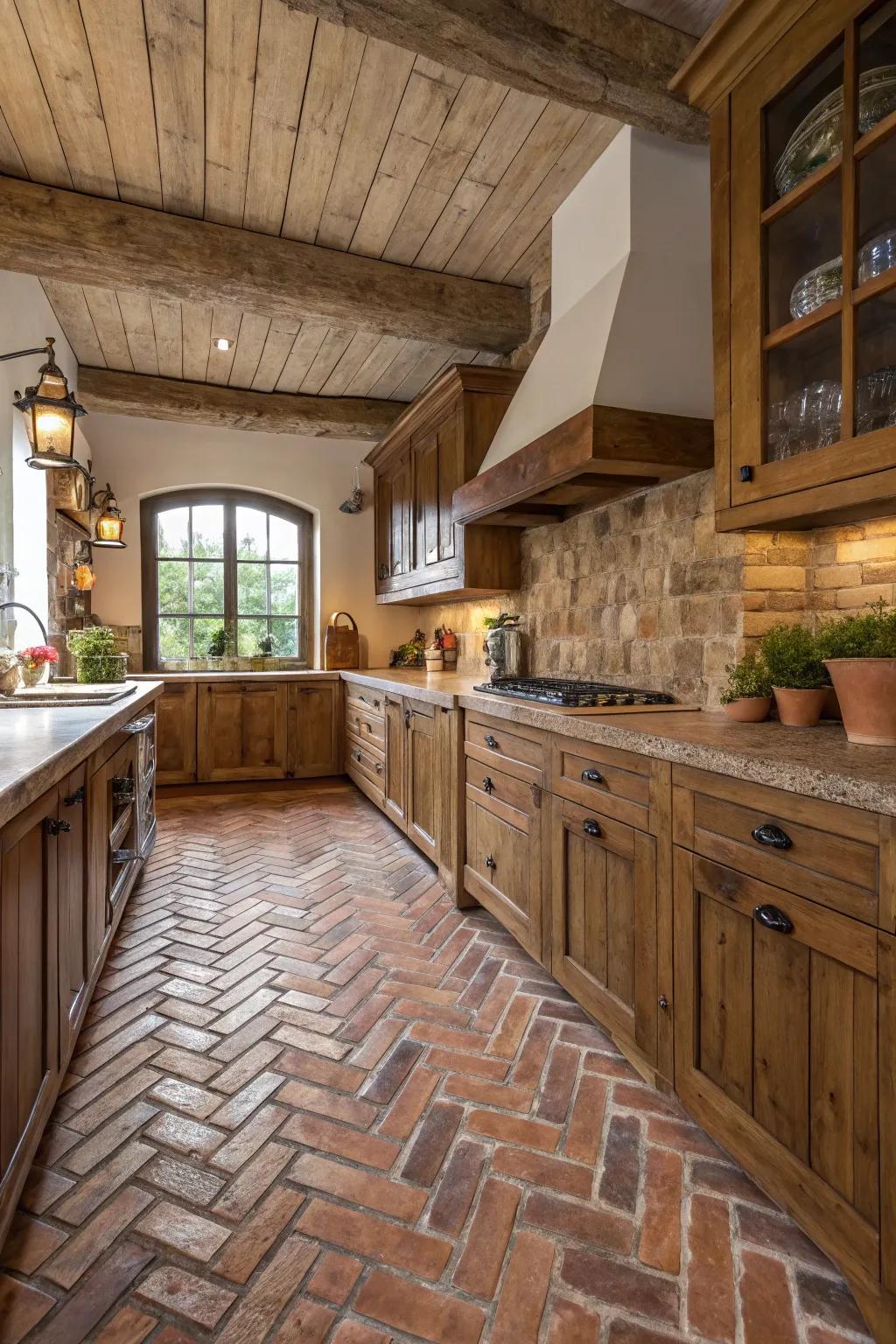
If you want to add instant sophistication to your kitchen while keeping it rooted in rustic tradition, a herringbone pattern delivers every time. I love recommending this look because it’s both classic and dynamic.
The trick is to let the pattern do the talking—whether in your flooring, backsplash, or even a bold accent wall! Here’s how I help clients get the most out of their herringbone:
- Opt for natural materials like wood or stone for warmth.
- Keep grout lines subtle for a seamless, elevated feel.
- Use herringbone sparingly alongside simpler textures to avoid overwhelming the space.
- Embrace imperfections—slight color variation adds rustic character.
Include a few well-loved utensils on your counter, or pair a herringbone pattern with hand-thrown ceramics for an inviting, lived-in effect.
There’s no rulebook for rustic elegance—just your own creativity, a dash of courage, and a fondness for the past.
A few things you might like:
5. Why a Substantial Kitchen Island Became My Clients’ Heart of the Home
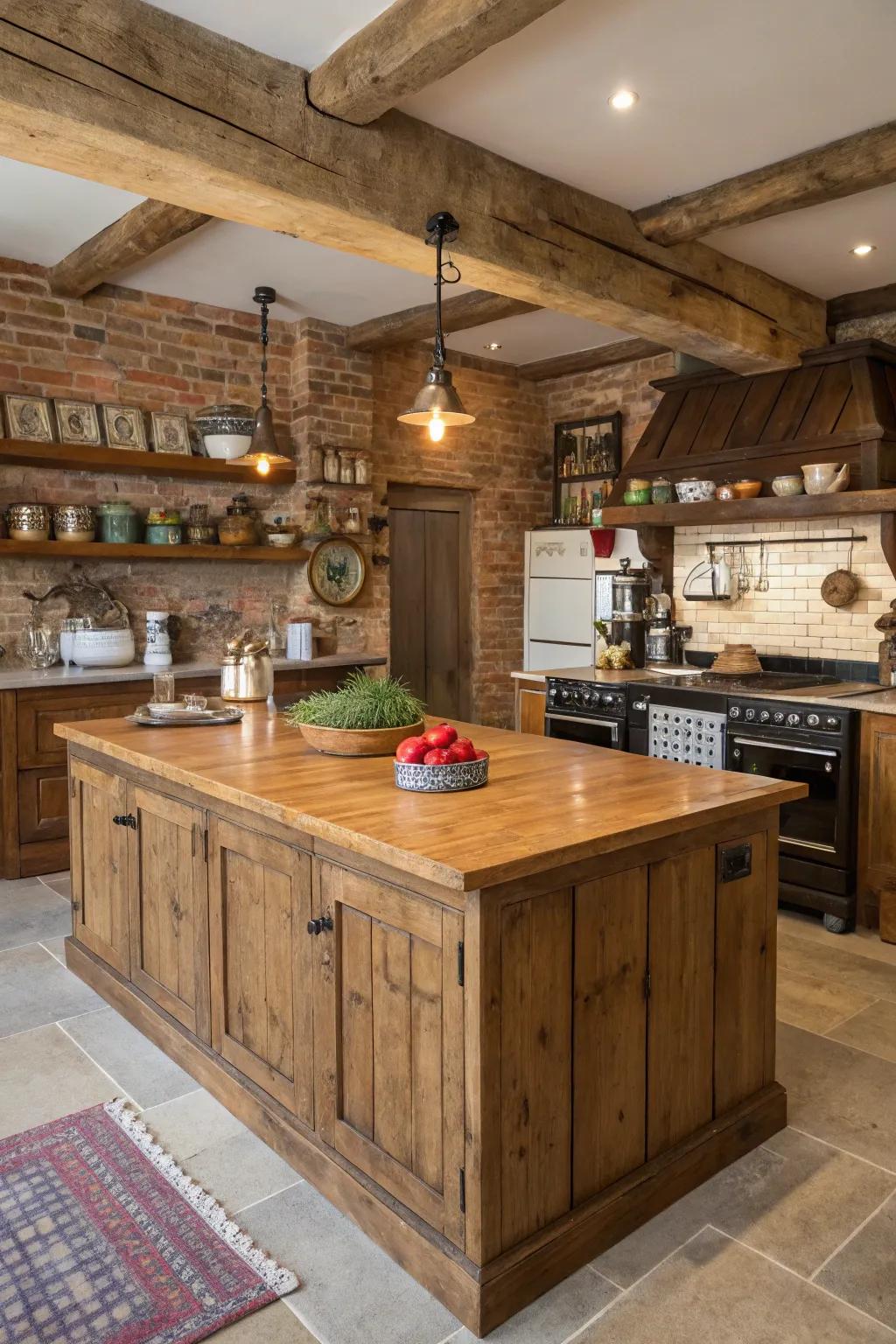
Your kitchen island can be so much more than a spot to chop vegetables or set down a casserole dish—it can become the very soul of a rustic kitchen, embodying utility, warmth, and connection.
When I worked with the Thompsons on their farmhouse renovation, the kitchen island was at the center of every conversation. We talked about family breakfasts, after-school snack stations, and even baking marathons that had flour dusting every corner! The right island design linked these dreams to daily life. I often suggest these must-have features for a rustic look:
- Use reclaimed or distressed wood for an authentically aged feel.
- Install a butcher block countertop for enduring beauty and durability.
- Build in deep storage shelves and open cubbies for pots, pans, and baskets.
Extra seating can turn your island into an informal dining space, while a pot of fresh herbs or a vintage breadbox adds those cozy, lived-in vibes. Don’t be afraid to mix finishes—worn metals and matte paint can work together for that effortless, rustic charm.
A kitchen island isn’t just a piece of furniture—it’s the gathering place, the project spot, and the centerpiece where everyone feels at home.
Possibly helpful picks:
6. Show Off Your Style!
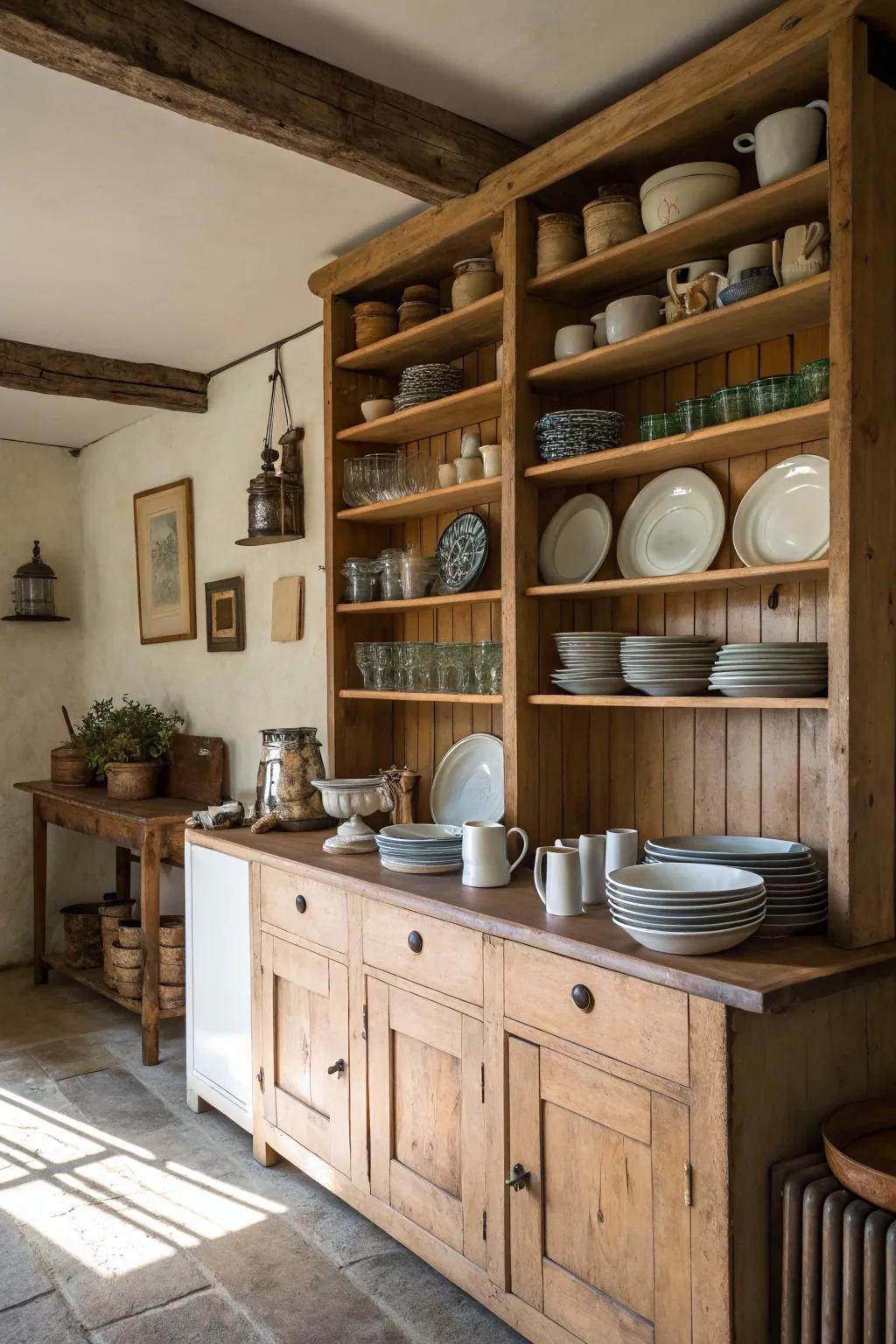
Open shelving is the secret ingredient for a light, airy rustic kitchen. It invites you to put your prettiest dishes and glass jars on display, turning everyday essentials into a style statement.
Don’t be afraid to mix materials and let your personality shine.
May just do the trick:
7. The Heart of a Rustic Kitchen: Crafting a Showstopping Range Hood
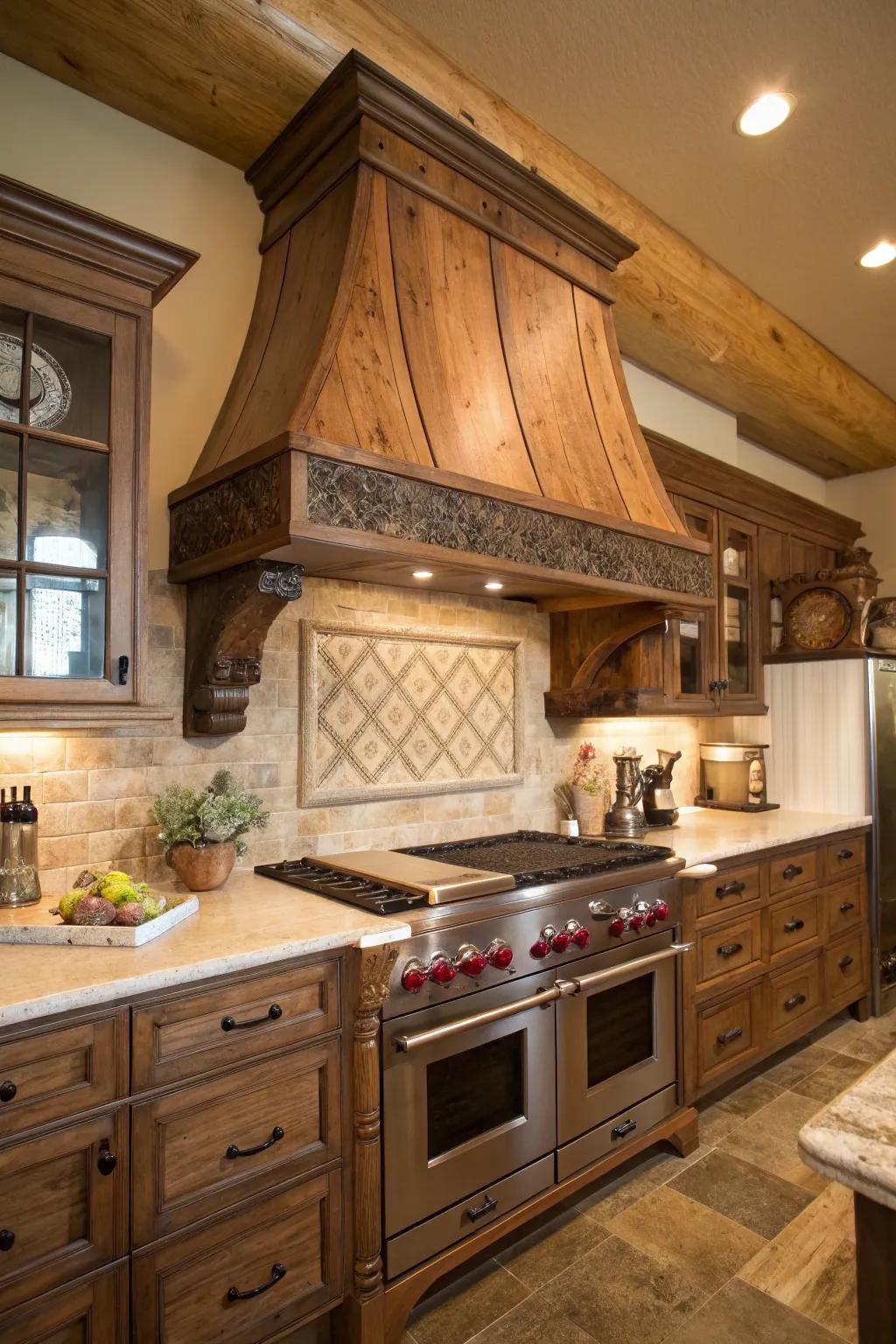
A rustic hood isn’t just a functional necessity—it’s often the beating heart of a country-inspired kitchen. Picture a grand wooden canopy, maybe trimmed with aged metal, drawing eyes upward and anchoring the whole design. When thoughtfully designed, it brings both artistry and a sense of tradition to the space.
I’ve found that the best rustic hoods are those that echo other elements in the kitchen, whether it’s reclaimed barn wood from the shelving or iron accents on cabinet handles. One of my clients, Celeste, wanted her kitchen to feel welcoming but also a bit grand. We chose a chunky wooden hood with custom metal strapping, and every time she fires up her stove, it feels like an event—not a chore.
Could your kitchen’s hood become the signature element everyone notices? Don’t be afraid to dream big and let your kitchen’s personality take center stage.
Possibly handy products:
8. Natural Edges
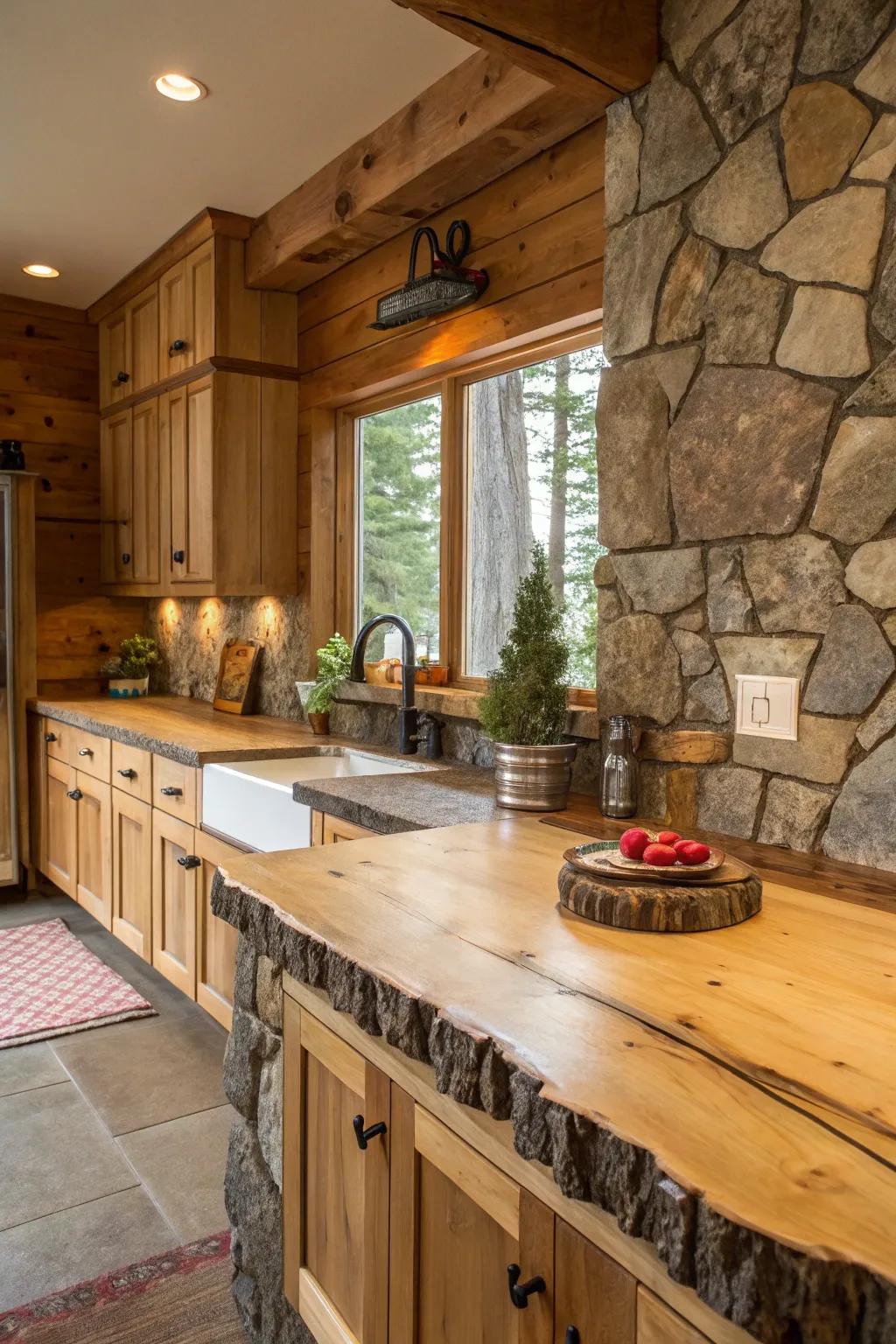
There’s something irresistible about a live-edge countertop. The gentle curve of wood, left just as nature intended, brings a raw grace to your kitchen space and makes everything feel more grounded.
Pairing these organic surfaces with simple tiles or aged metals lets their beauty stand alone. Try running your hand along the edge—can you feel the story of the tree? These counters don’t just look special, they invite touch.
Explore these options:
9. Why Exposed Beams Matter in Rustic Kitchens
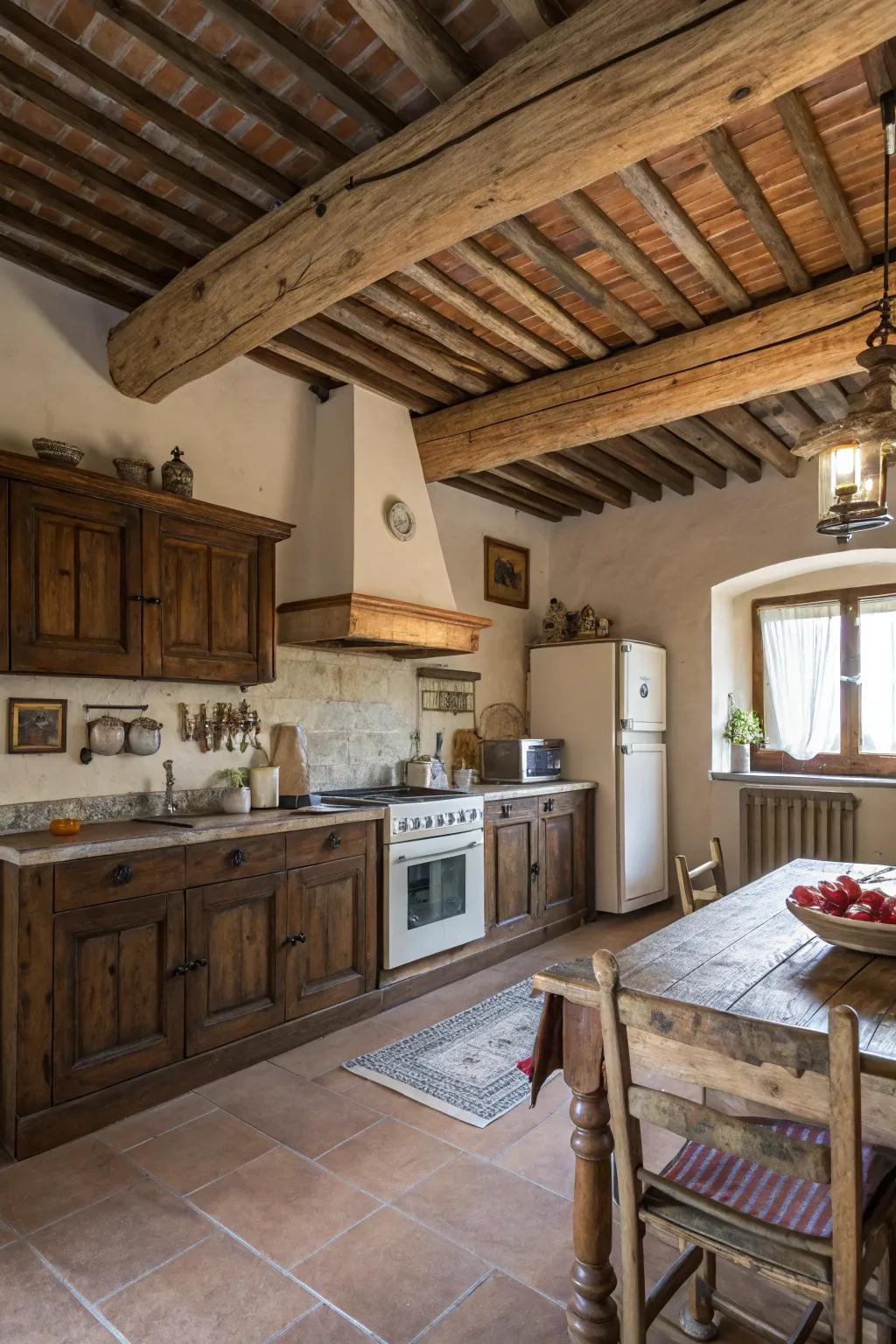
When you walk into a rustic kitchen and your gaze travels upward, what’s the first thing you notice? For me, it’s always the exposed beams—those sturdy, weathered lines that instantly warm up the room and tell a silent story of craftsmanship.
Exposed beams aren’t just structural; they become the backbone of the entire aesthetic, grounding the space with texture and natural beauty. I love leaving them unfinished or lightly sealed, allowing their knots, grain, and the passage of time to shine through. Isn’t there something magical about wood that isn’t trying to be perfect?
I once worked with clients named Mia and Tom, who hesitated at first to reveal their old ceiling beams. They worried they’d look too rough or out of place. Together, we carefully cleaned and sealed each beam, leaving their unique character undisturbed. When the rest of their kitchen came together—with soft linens, vintage copperware, and hand-thrown pottery—the beams became the crown jewel, radiating warmth and strength. Their guests always comment about how the room just feels like a big hug.
If you’re considering adding beams, here’s what I always suggest:
- Match the wood tone to at least one other kitchen element for cohesion.
- Layer in softer textures—think linen curtains or woven rugs—to balance the beams’ sturdiness.
- Don’t be afraid of imperfections; let your beams tell their true story.
Sometimes, letting your home’s bones show is the most beautiful choice you can make.
These products might help:
10. Stories Etched in Wood: A Rustic Essential
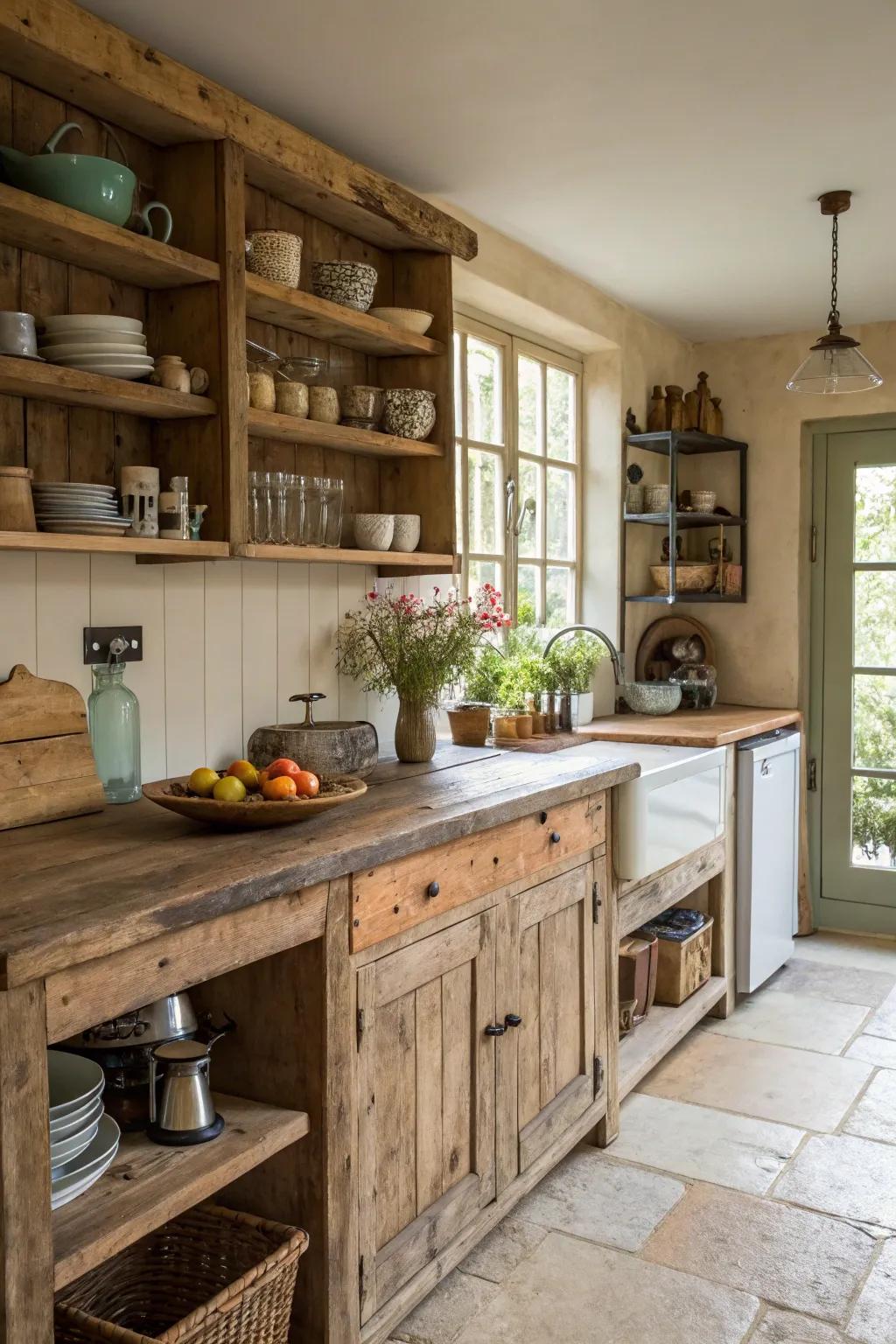
Few materials evoke the same depth of feeling in a kitchen as reclaimed wood. Each mark, knot, and groove tells a story—one that brings both character and authenticity to the heart of your home. If you want to infuse your kitchen with a sense of history and tactile coziness, reclaimed wood is a must.
There’s nothing quite like running your hand over a wooden counter and imagining the lives it touched before it found its way to you.
In my years working with clients, I’ve seen reclaimed wood used in a stunning array of creative ways. Anna and Marcus, for example, dreamed of open shelving that would showcase their collection of vintage cookware while giving their kitchen true personality. We sourced weathered boards from a local salvage yard and crafted shelves that now hold not just dishes, but cherished memories. If you’re considering adding this timeless material to your own space, consider these ideas:
- Install reclaimed wood countertops for a durable work surface with one-of-a-kind texture.
- Use salvaged planks as open shelving to display your favorite pieces and keep essentials within reach.
- Swap standard cabinet doors for reclaimed wood facades that create visual impact and keep things feeling grounded.
Remember, choosing reclaimed materials isn’t just about “going green”—it’s about creating a kitchen where every surface whispers stories from another time. Let your kitchen wear its history with pride!
Useful items to consider:
11. Let There Be Glow…
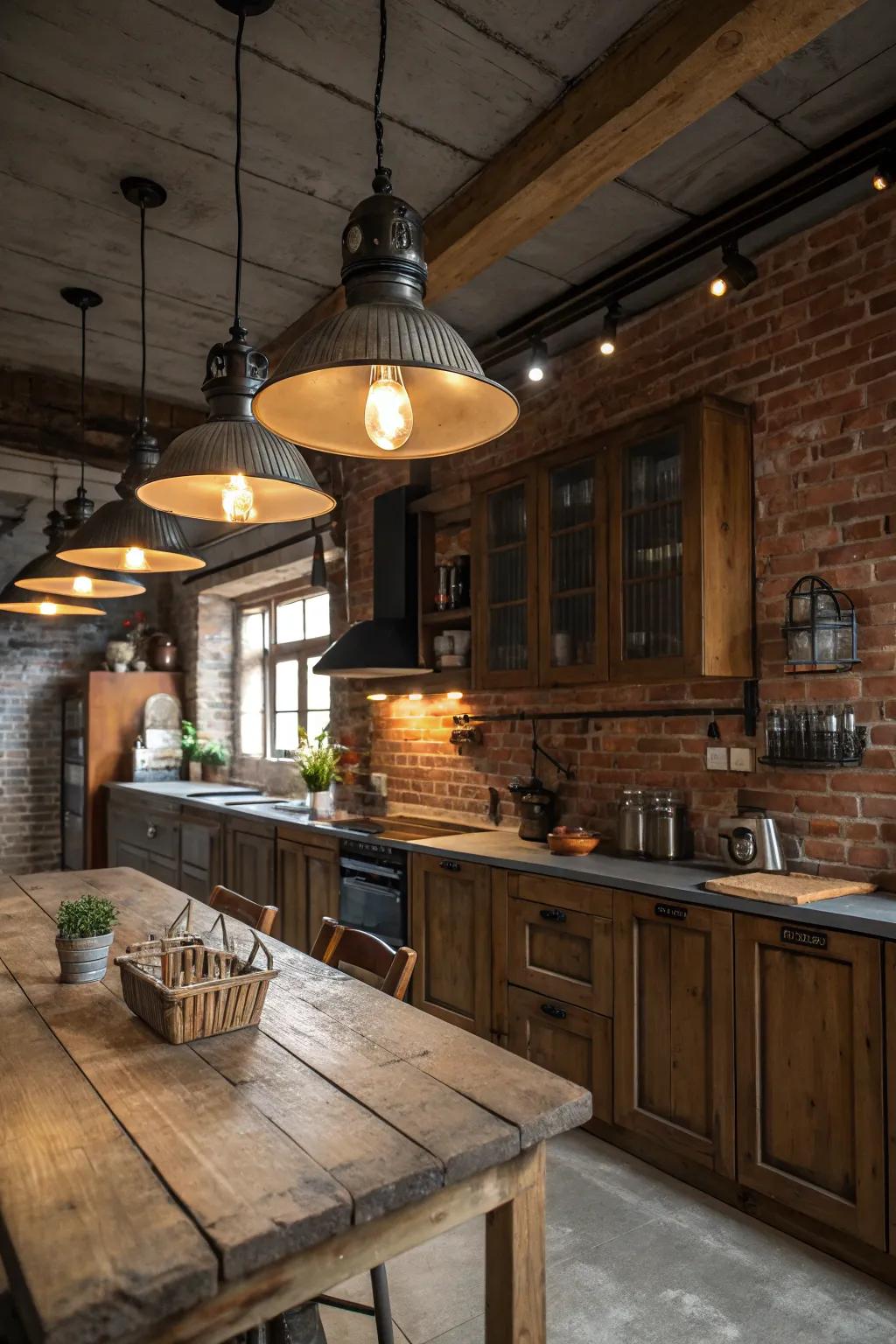
Industrial lighting is my go-to twist for rustic kitchens. If you want your space to turn heads, swap out those basic bulbs for weathered pendant lamps, iron sconces, or those irresistible Edison bulbs.
The right light doesn’t just brighten a room—it tells a story. Trust me, your countertops (and your mood) will thank you.
You might like:
12. How Do Flea Market Finds Transform a Kitchen?
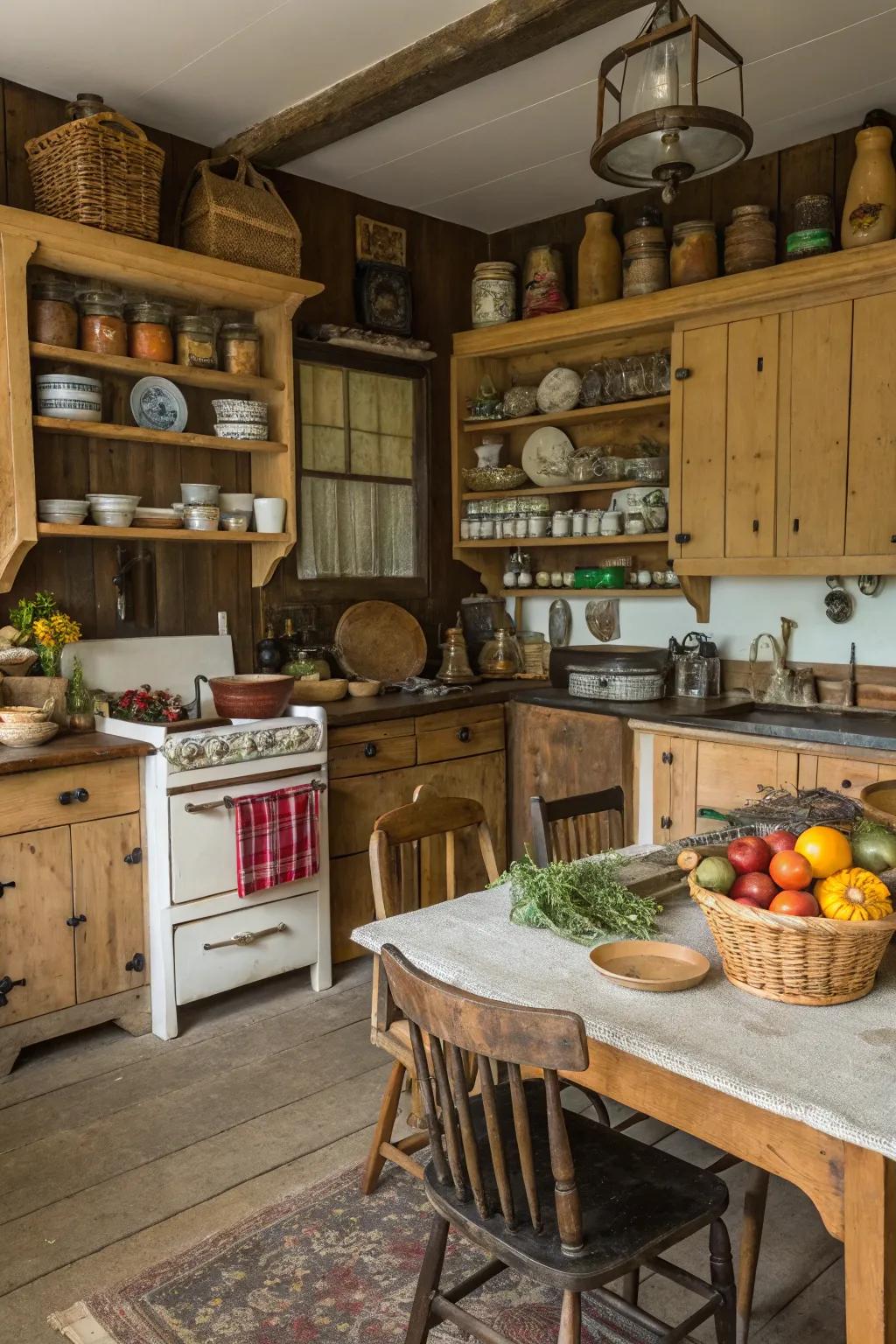
Treasure hunting for your kitchen isn’t just about finding the right thing—it’s about discovering pieces that evoke story and spark nostalgia. Flea markets are full of hidden gems waiting to add personality and comfort to your rustic kitchen.
Have you ever noticed how a well-worn rolling pin or a collection of mismatched enamel mugs can make a space feel instantly lived-in? There’s a magic in pieces that have already been loved, and it’s this patina—the gentle marks of time—that sets rustic kitchens apart. These finds aren’t just decor; they’re conversation starters and memory makers.
If you’re new to the flea market circuit (or just need a little encouragement), here’s how to approach your next outing:
- Start with a wish list, but stay open to surprises.
- Look for genuine wear—little dings, faded paint, or a chipped edge can be charming.
- Ask vendors about provenance; sometimes a good story is the best part.
- Picture how each piece will interact with what you already own.
I remember working with a client, Amanda, whose kitchen was feeling too sterile and modern for her taste. She loved the idea of rustic charm but didn’t want it to feel forced. We spent a Saturday at a local flea market, where Amanda fell for an antique breadbox with a faded floral design. We also found a quirky set of miniature spice drawers that fit perfectly near her stove. These additions transformed her kitchen into a space that felt instantly hers—filled with items that made her smile and sparked conversation when friends gathered.
Never underestimate the power of a small, story-packed object to breathe life into your kitchen. Let your heart guide you, not the trends.
A few choices to try:
13. Incorporate Bold Color Accents
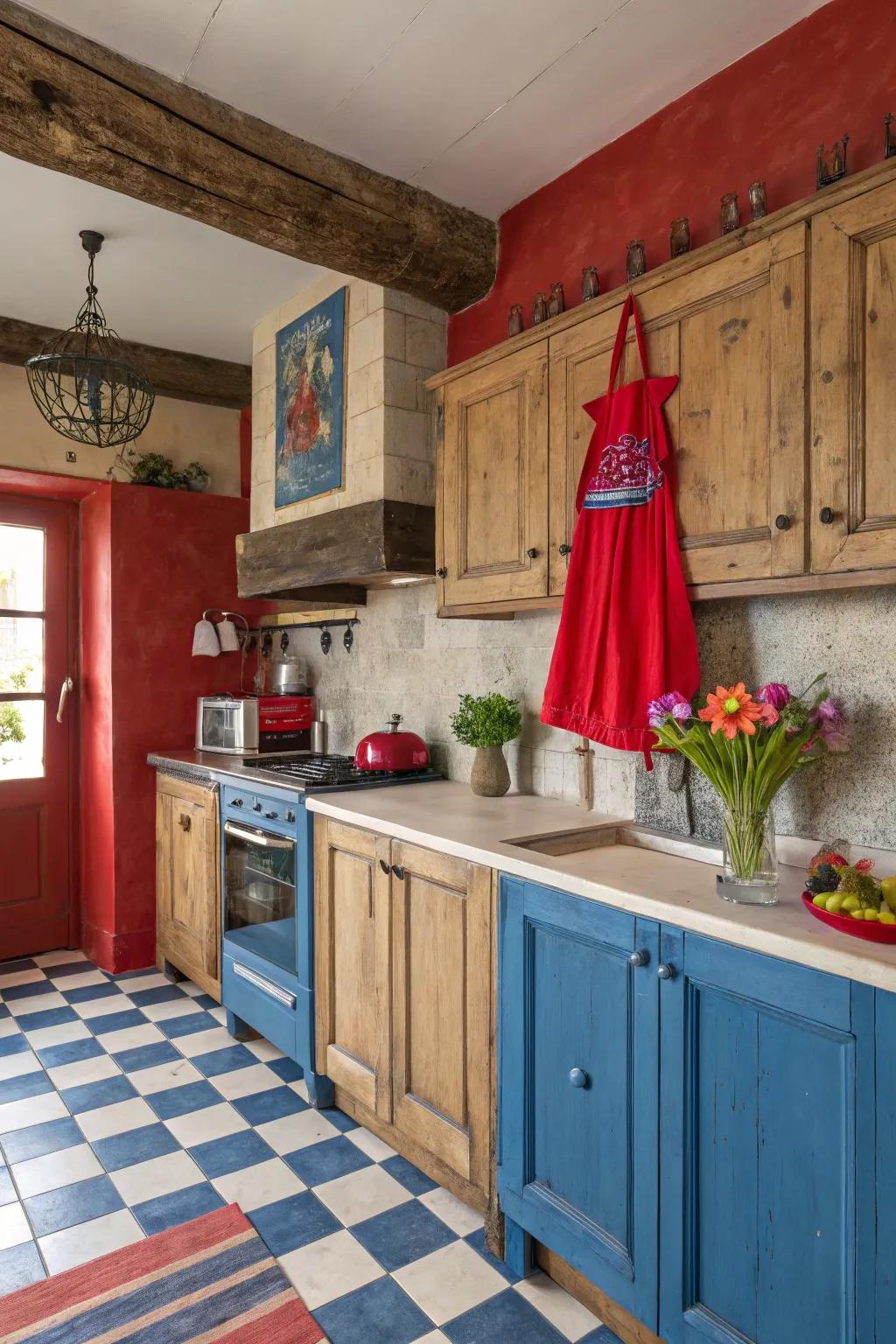
Bold color accents, like apple red or deep blue, can add a playful twist to a rustic kitchen. I’ve seen these colors transform a space with unexpected vibrancy.
You might give these a try:
14. Which Vintage Fixture Will Steal the Show?
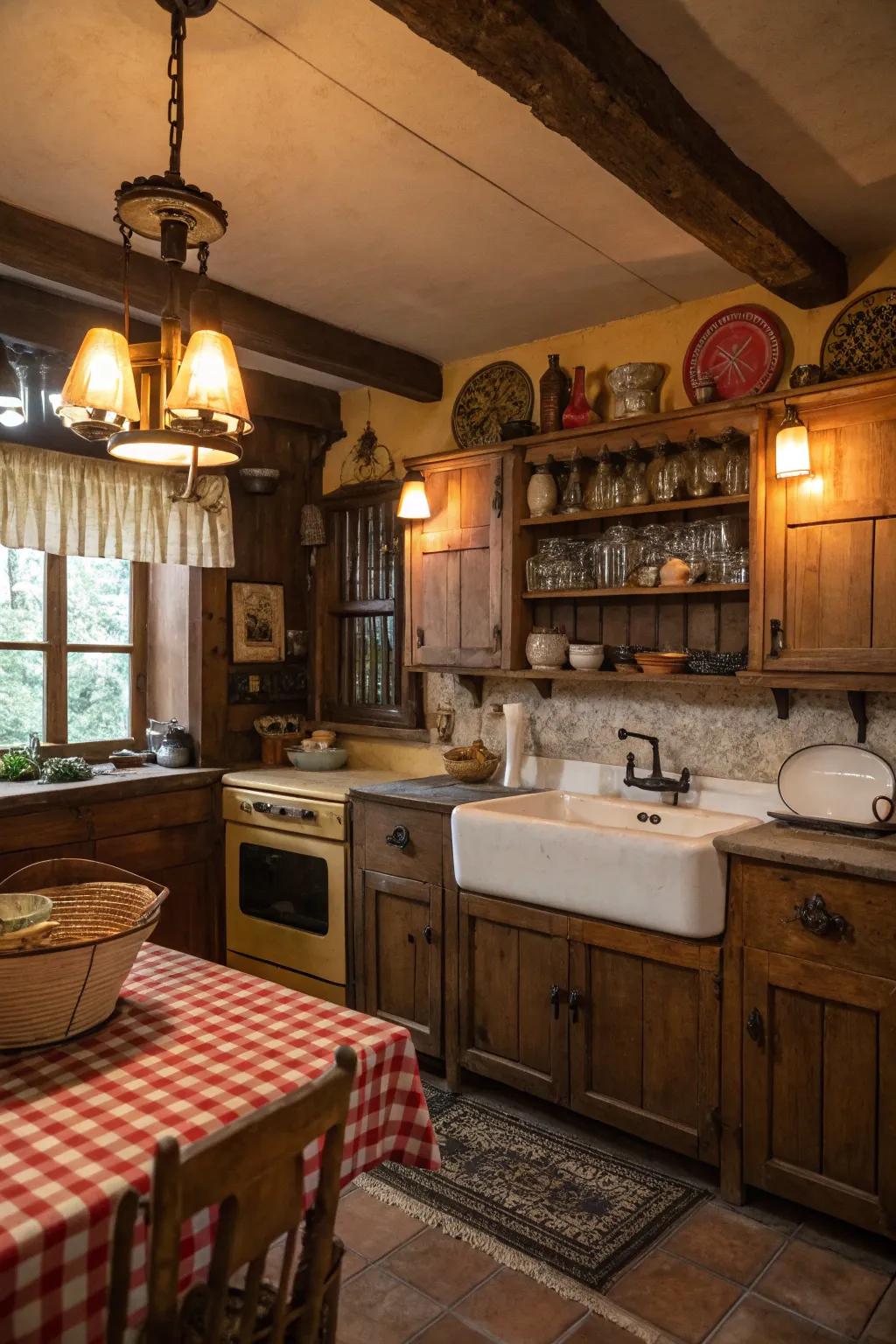
There’s something so delightful about stumbling upon a one-of-a-kind vintage fixture. It’s like finding hidden treasure!
I once helped Linda and James track down an oversized enamel barn pendant for their rustic kitchen.
It was chipped in all the right places, and its patina sparked stories every time guests walked in.
Unique fixtures—be it weathered hardware, a quirky faucet, or an unexpected light—always add a twist. Trust me, a little boldness here pays off in spades.
Those offbeat choices are what set your kitchen apart.
Items that may come in handy:
15. Why Choose a Farmhouse Sink?
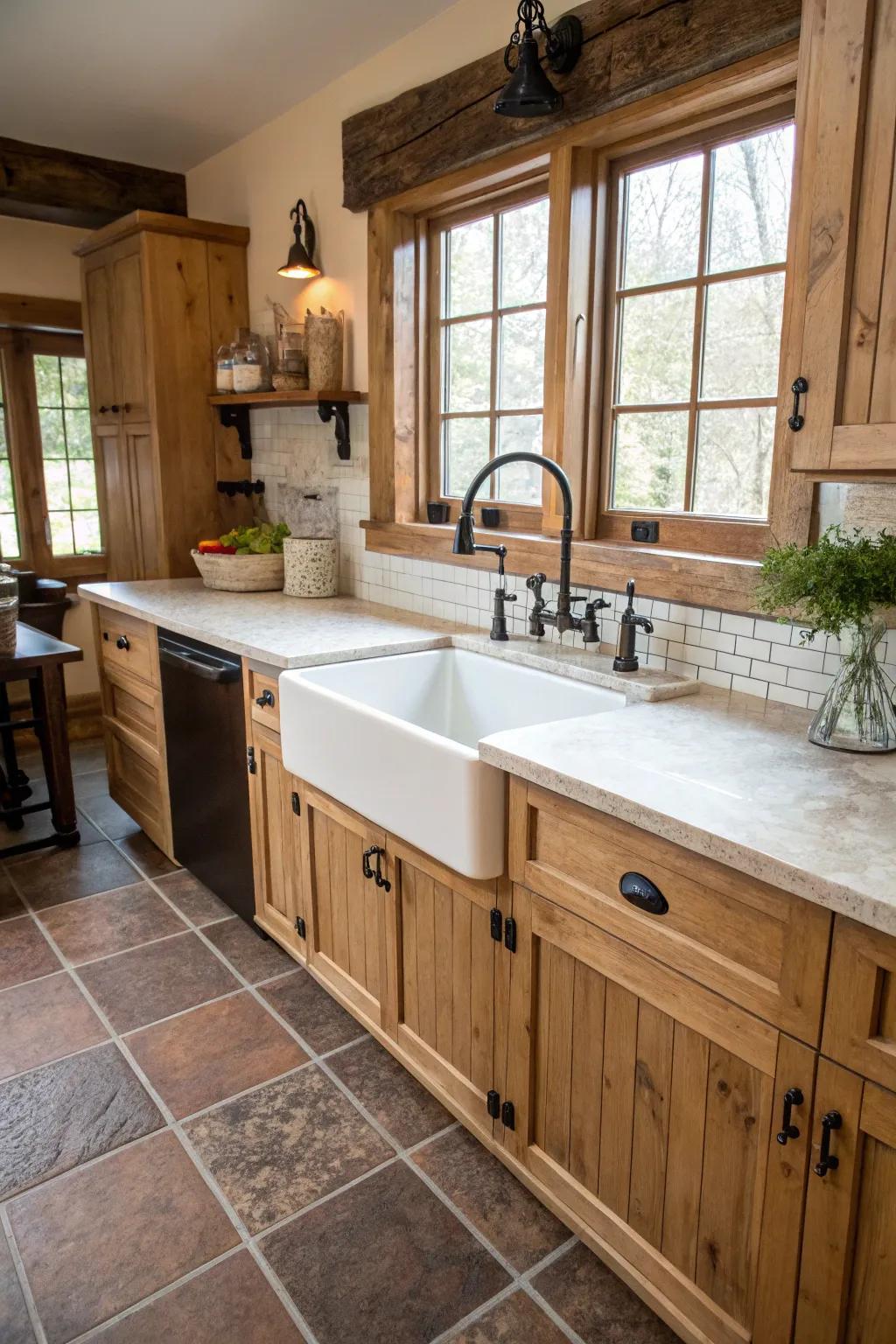
A farmhouse sink is a true classic when it comes to rustic design—and for good reason. It offers generous space for stacking pots and pans, while its vintage appeal brings a touch of old-world charm to even the most modern kitchen.
Here are two quick tips if you’re dreaming of this iconic feature:
- Pair a white farmhouse sink with a bold black iron faucet to create striking contrast.
- Consider a rustic wood cabinet base to enhance the heritage vibe and add coziness.
A few helpful options:
16. Which Colors Whisper ‘Warmth’? Cozy Palettes for Every Rustic Kitchen
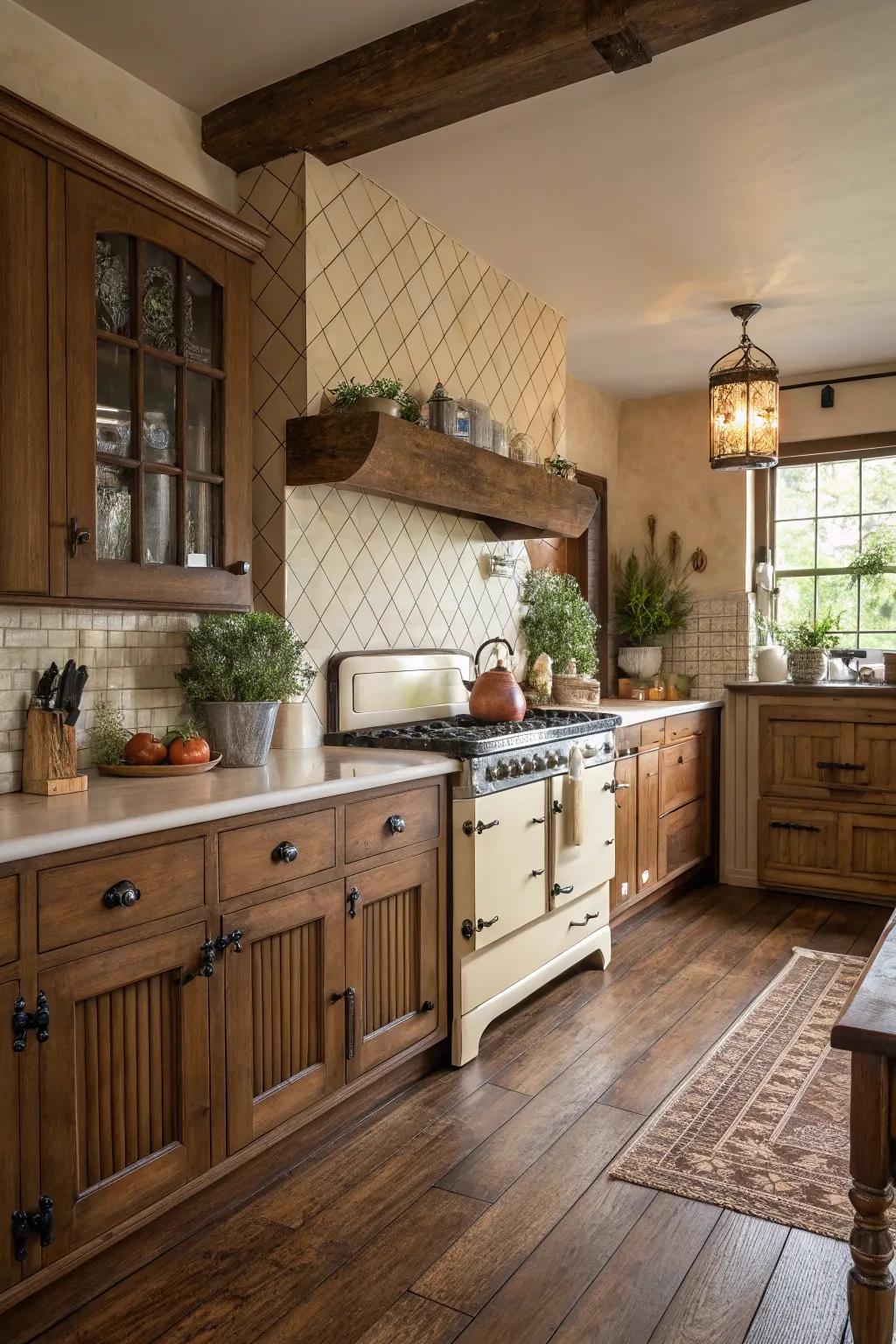
Color is a kitchen’s heartbeat.
I’ve helped many clients discover that you don’t have to completely overhaul your kitchen to introduce warmth. In fact, the subtlest neutral and earthy tones often carry the most impact. Think of soft taupes caressing the walls, rough-hewn beams in deep walnut, or a gentle cream backdrop making wood tones pop. Try pairing these shades for instant rustic harmony:
- Warm gray and honey oak
- Soft cream and natural rattan
- Dusty olive with aged copper accents
- Rustic brown and weathered stone
Want a quick refresh? Swap out cabinet hardware, layer a brown area rug, or introduce cream ceramics on open shelving. Even the tiniest color tweak can make your kitchen feel like a welcoming hug at the end of a long day. Isn’t that the whole point?
Your kitchen’s colors are the quiet hosts of every meal.
Some ideas to consider:
17. Texture Tells a Story: How Brick and Wood Ground a Kitchen in Comfort
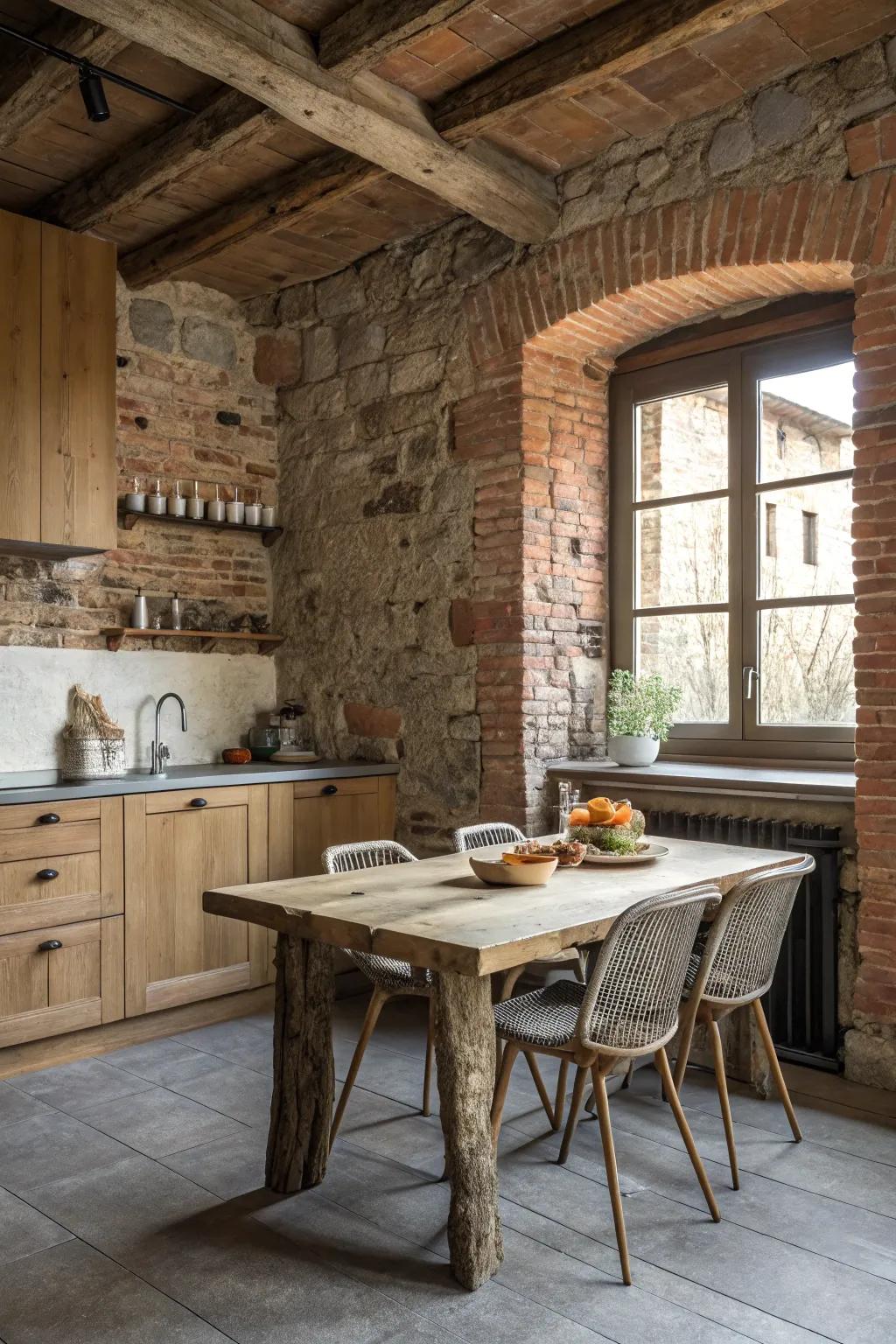
Rough-hewn beams, exposed brick, and natural woods have a way of making any kitchen feel rooted and real. I always say, let your space be a feast for the fingertips as well as the eyes! That’s the secret ingredient to a truly rustic vibe—inviting everyone to linger, touch, and connect.
Brick by brick, board by board, let texture do the talking.

